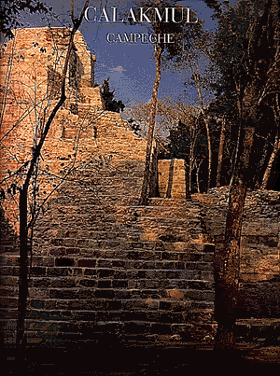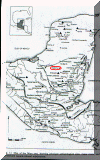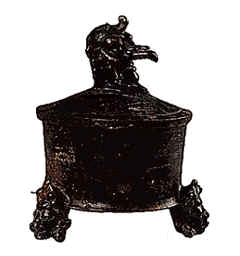

This page has some images over 30k and may load slowly.

 Located on the Yucatan Peninsula,
the lowland Maya site of Calakmul lies approximately 35 km from the Guatemalan border and
is in the state of Campeche in present-day Mexico. It is situated on high ground
near a large marsh. The central area of architecture covers some two square
kilometers and contains over 1,000 structures. Residential remains for the city
cover some twenty square kilometers, and the remains of its extensive system of canals and
reservoirs, which once served a population of over 50,000, surround the sight.
Located on the Yucatan Peninsula,
the lowland Maya site of Calakmul lies approximately 35 km from the Guatemalan border and
is in the state of Campeche in present-day Mexico. It is situated on high ground
near a large marsh. The central area of architecture covers some two square
kilometers and contains over 1,000 structures. Residential remains for the city
cover some twenty square kilometers, and the remains of its extensive system of canals and
reservoirs, which once served a population of over 50,000, surround the sight.
The first known report of Calakmul was made by Cyrus Lundell in 1931. The following year Sylvanus Morley travelled to the site to record the dated monuments. Three more expeditions were made in the next few years, the final one in 1938. After that work at Calakmul ceased for the next 44 years, but in 1982 William J. Folan of the Universidad Autonoma de Campeche resumed research. Since then, Folan and his crew have produced a new settlement map and carried out excavations which continue today.
Though Folen has found a large amount of ceramic evidence that demonstrates the site was occupied at least by the Middle pre-Classic and possibly earlier, the first inscribed date at Calakmul does not appear until what corresponds to the year 514 A.D. It is around this time that Calakmul emerges as a powerful force in the Peten, organizing itself into a four-fold, hexagonal state wherein exists a nested hierarchy of subservient outlying towns who in turn preside over smaller villages. These villages govern even smaller political units all of which are ultimately under the power of Calakmul.
The first sign of Calakmul's growing influence appears in 537 A.D. when the city's king Cu-Ix is mentioned on a lintel at the site of Yaxchilan. Nine years later "Cu-Ix" appears again, this time on Stela 25 at Naranjo. Folan and others have speculated that the presence of "Cu-Ix" at these respective sites is an indication that Calakmul was culling political favor with other powerful polities in the Peten. This indeed appears to be the case because by 562 A.D. Calakmul, from its position north of Tikal, had formed alliances with Naranjo in the east, Yaxchilan in the west, and Caracaol in the south. This alliance allowed them to encircle the great city of Tikal and ultimately defeat it in 562 A.D.
Over the next one hundred and thirty years, Calakmul enjoyed the height of its influence. It expanded its power-base and increased its wealth. Folan has noted that most of the great architecture at Calakmul occurred between 550 A.D. and 700 A.D. However, their ability to keep Tikal in a subservient role was hampered by infighting between Caracaol and Naranjo. In exactly what manner Tikal was able to re-assert itself, whether through political intrigue or simple muscle, it is not clear. However, epigraphers have decoded inscriptions that state Jaguar-Paw, the ruler of Calakmul, was defeated by Ah-Cacaw of Tikal in 695 A.D.
Despite their defeat by Tikal, Calakmul seems to have retained its role as a dominant center well into the eighth century. Joyce Marcus, Folan's epigrapher, has found the cities glyph inscribed with those of Copan, Tikal, and Palenque inscribed on Stela A at Copan in 731 A.D. She believes that this indicates Calakmul's continued political clout in the Peten.
Recorded history at Calakmul ends abruptly in 810 A.D. Whether the city could not muster the resources for continued monuments or whether some outside polity prevented them from doing so, remains unclear. However, from inscriptions at Seibal, archaeologists know that Calakmul was occupied as late as 850 A.D. Additionally, Folan has found evidence that the site continued to be occupied into the proto-historic (ca. 1450-1550 A.D.), though he undercuts his assertion by stating that the occupation was most likely transient and ceremonial in nature.

The urn shown above was located in Burial VIII. Among the other artifacts contained in Burial VIII were 6 jadeite masks, 3 stone pendants, a shell-studded garment, and a stingray spine.

This mask, made of 168 individual pieces of jade, from Tomb I, Structure III, was excavated by Mario Coyoc Ramirez (1989) and Sophia Pincemin (1989).

This peccary head was excavated by William J. Folan from a royal tomb at Calakmul and was at one time used to support a tetrapodal dish.
The thumbnails below contain two site maps and one architectural drawing of Calakmul's Grand Plaza. The site maps have been taken from "Calakmul: New Data from an Ancient Maya Capital in Campeche, Mexico," an article by William J. Folan that appeared in a 1995 issue of Latin American Antiquity (vol. 6, no. 4). Farther down, are brief descriptions of Buildings I-IV and XI. These descriptions have been either paraphrased or excerpted from Ramon Carrasco's on-line essay "Calakmul: The Archaeology of a Superpower." For Building XI, the ball court a link has been included to a quick time movie that allows a virtual reality tour of an actual Maya ball court. Though this movie does not depict the ball court at Calakmul, it does give a general idea as to what such a court looks like.
Structure I has proportions similar to Structure II.
"Structure II, which occupies the extreme south of the Grand Plaza, is a foundation of monumental proportions with a surface area of more than 100 meters (331 ft) on each side. The presence of pre-Classic ceramics in unsullied deposits at an open tunnel in this building shows that its fill corresponds to that of a substructure of the late pre-Classic era. Its sequence of construction preserves at least three substructures and four architectural phases: the first two, assoicated with ceramics in sealed contents; the second phase corresponds to the early Classic (250-600 A.D.) era."
Carrasco describes Structure III as a "'palace' in the classic Peten style." Structure III is unique among the main buildings at Calakmul in that it, unlike the others, never underwent any significant modifications during the entirety of occupation at Calakmul. Carrasco believes that this is because it housed "one of the most ancient lineages of Calakmul."
This structure represents one of the most complete building architectural sequences at Calakmul--the high pre-Classic through the terminal Classic. Guarding the entrance of one of its substructures is a carving of a leader "who emerges from a crevice in the monster of the earth." Carrasco believes that this carving may be a depiction of the legendary Cu-Ix, "the principal protagonist in the alliances among Calakmul, Naranjo, and Caracol in their struggle against the power of Tikal."
Not visible in the map shown above, Structure XI is a ball court situated in public space in Plaza I of the Great Acropolis. The structure represents architecture at Calakmul in the second half of the late Classic era. Also of note, is the spacial relationship between Structure XI and Structure XIII as Carrasco believes that this may be a symbolic arrangement linked to the myth of the hero twins in the Popol Vuh and their descent into Xibalba. To view a Maya representation of a ballplayer click here.
Folan, William J. 1995. Verification of a Maya Settlement Through Remote Sensing. Cambridge Archaeological Journal 5: 277-283.
Folan, William J. 1995. Calakmul: New Data From an Ancient Maya Capital in Campeche, Mexico. Latin American Antiquity 6: 310-334.
Folan, William J. 1992. Calakmul, Campeche: A Centralized Urban Administration Center in the Northern Peten. World Archaeology 1: 158-168.
Schele, Linda and Freidel, David. 1990. A Forest of Kings: The Untold Story of the Ancient Maya. New York: William Morrow and Company, Inc.
Sharer, Robert J. 1994. The Ancient Maya. Stanford, California: Stanford University Press.
http://rulfo.dca.udg.mx/Arte/Arque/calak.html
http://www.stevensonpress.com/Maya/Calakmul.html
http://www.mexico-travel.com/states/s04/257zz3.htm
http://studentweb.tulane.edu/~dhixson/soon.html
DEBUNKING THE PYRAMIDS - https://anth507.tripod.com/pyramids.htm
SHAMANISM AND ITS RELATIONSHIP TO MODERN MONSTERS - https://anth507.tripod.com/termpaper.htm
THE ORION MYSTERY (BOOK CRITIQUE) - https://anth507.tripod.com/orionmystery.htm
THE MESSAGE OF THE SPHINX (BOOK CRITIQUE) - https://anth507.tripod.com/messageofthesphinx.htm